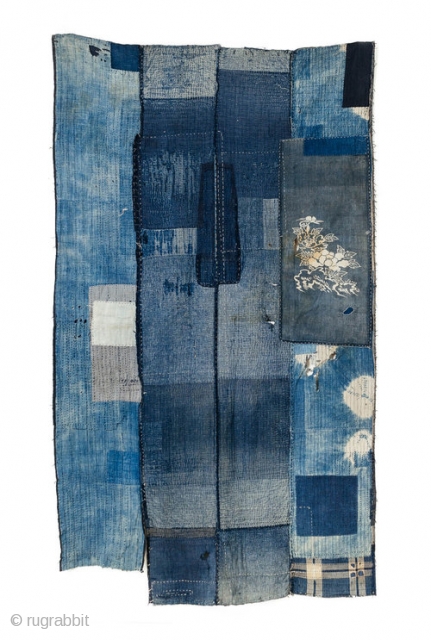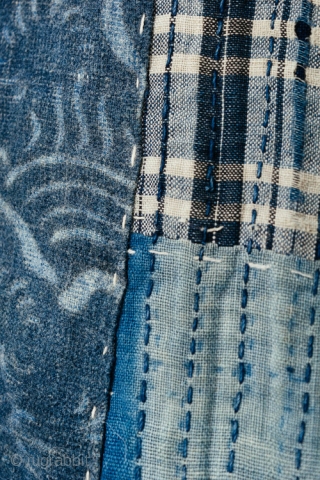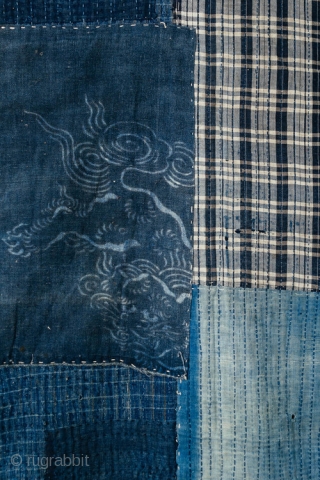Back
This is a stunning example of an antique Japanese boro futonji with many patches and thousands of sashiko stitches.
Both sides of this boro are equally impressive. The first and second photographs shown here present the proper reverse and front, respectively, of the futonji. Each is beautiful and unique, with a wide array of antique Japanese hand loomed cotton textiles all held together with dense sashiko stitching.
The proper reverse displays a beautiful geometry of patchworked, variegated indigo cottons. Of note is the indigo kumo or "spiderweb" shibori cotton patch on the lower left, and just above it a tsutsugaki floral pattern, perhaps salvaged from an old furoshiki or other textile.
The front of this futon is composed of solid indigos, check, and kasuri cottons. We especially enjoy the tsutsugaki patch near the top depicting a shishi, or guardian lion.
This is a very large and excellent example of a Japanese boro folk textile, and a highly collectible piece. In just one futonji we have several good examples of different Japanese techniques--sashiko, kasuri, tsutsugaki, shibori--arranged in an unintended but artful pattern.
Dimensions: 52.5 x 78.5 in; 133 x 199cm Late 1800s to early 1900s
For more antique Japanese textiles, please visit our online gallery at: http://www.orimetextiles.com
Both sides of this boro are equally impressive. The first and second photographs shown here present the proper reverse and front, respectively, of the futonji. Each is beautiful and unique, with a wide array of antique Japanese hand loomed cotton textiles all held together with dense sashiko stitching.
The proper reverse displays a beautiful geometry of patchworked, variegated indigo cottons. Of note is the indigo kumo or "spiderweb" shibori cotton patch on the lower left, and just above it a tsutsugaki floral pattern, perhaps salvaged from an old furoshiki or other textile.
The front of this futon is composed of solid indigos, check, and kasuri cottons. We especially enjoy the tsutsugaki patch near the top depicting a shishi, or guardian lion.
This is a very large and excellent example of a Japanese boro folk textile, and a highly collectible piece. In just one futonji we have several good examples of different Japanese techniques--sashiko, kasuri, tsutsugaki, shibori--arranged in an unintended but artful pattern.
Dimensions: 52.5 x 78.5 in; 133 x 199cm Late 1800s to early 1900s
For more antique Japanese textiles, please visit our online gallery at: http://www.orimetextiles.com
price:
$1480.00
- Home
- Antique Rugs by Region
- Category
- Profiles
- Post Items Free
- Albums
- Benaki Museum of Islamic Art
- Budapest: Ottoman Carpets
- Gulbenkian Museum
- Islamic Carpets. Brooklyn
- Islamic Textiles. Brooklyn
- Konya Museum: Rugs
- MKG, Hamburg
- MMA: Caucasian Carpets
- MMA: Mamluk Carpets
- MMA: Mughal Indian Carpets
- MMA: Ottoman Carpets
- MMA: Safavid Persian Carpets
- MMA: Turkmen Rugs
- McCoy Jones Kilims
- Ottoman textiles. Met
- Philadelphia Museum
- Rugs and Carpets: Berlin
- Seljuqs at the Met
- TIEM, Istanbul: Carpets
- V&A: Classical Carpets
- Vakiflar Carpets: Istanbul
- Baluch Rugs: Indianapolis
- Gallery Exhibitions
- Jaf an Exhibition
- Alberto Levi Gallery
- Andean Textile
- Christie's London: 2016
- Francesca Galloway
- HALI at 40
- ICOC Washington, DC 2018
- Jajims of the Shahsavan
- London Islamic Week April, 2018
- Mongolian Felts
- Navajo Rugs: JB Moore
- Persian Piled Weavings
- SF Tribal & Textile Art Show 2020
- SF Tribal 2019
- Sotheby's: C. Alexander
- Turkish Prayer Rugs
- Turkmen Main Carpets ICOC 2007















